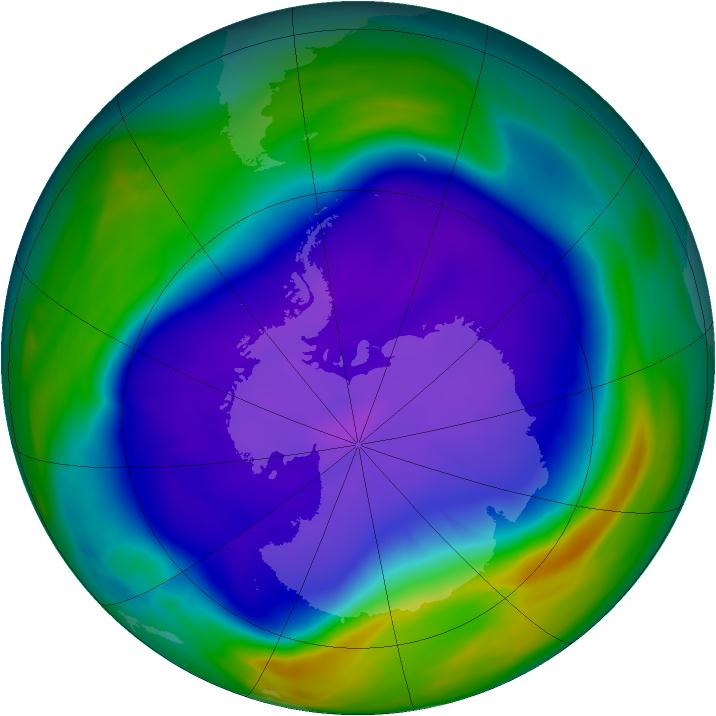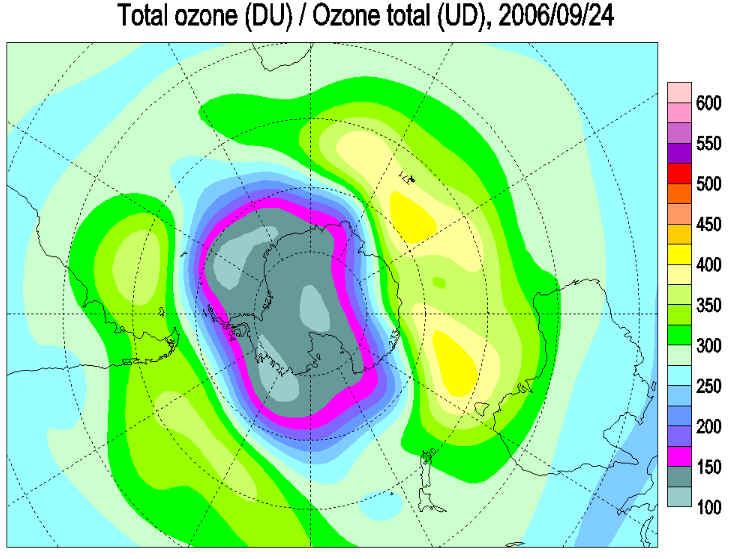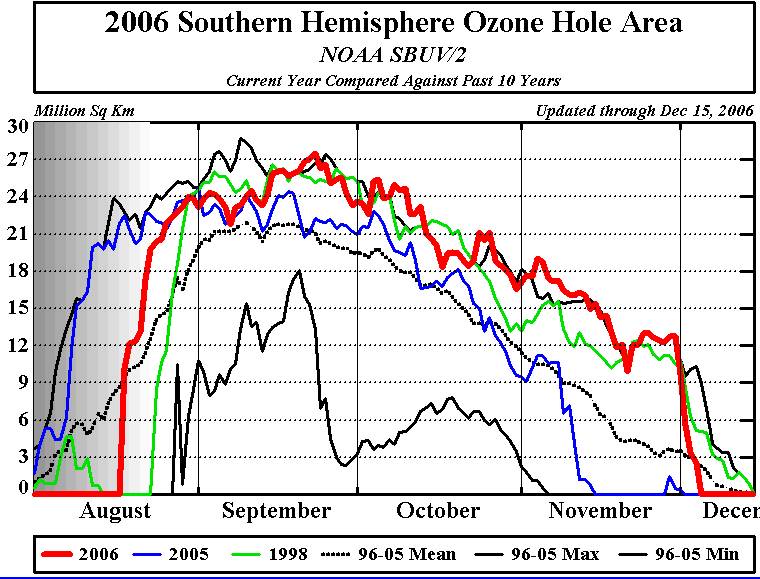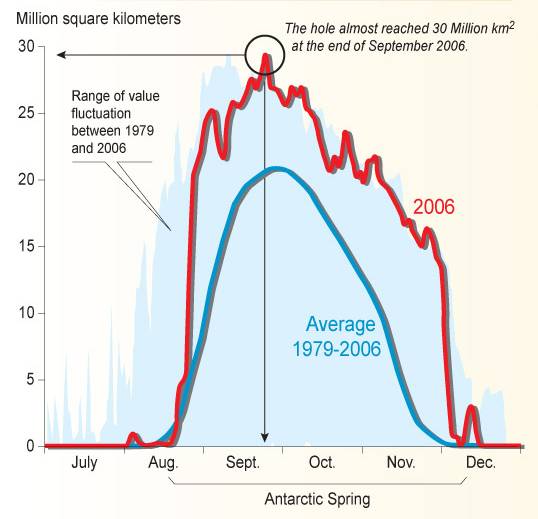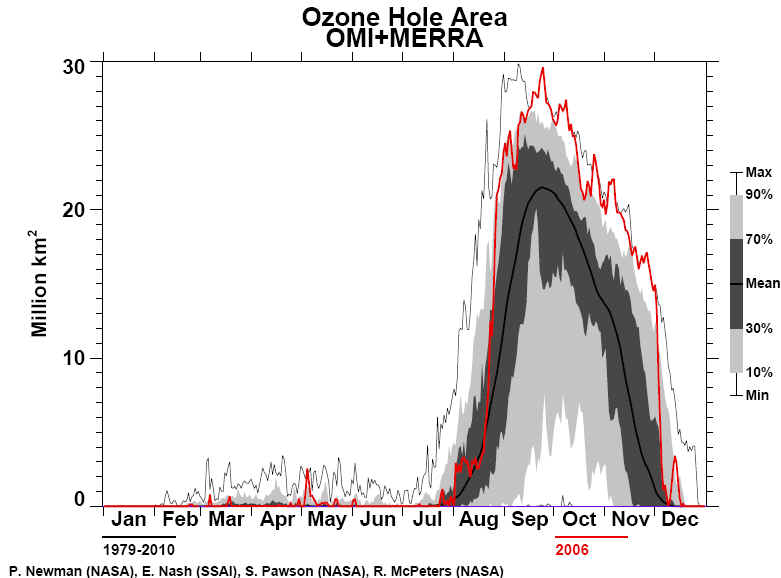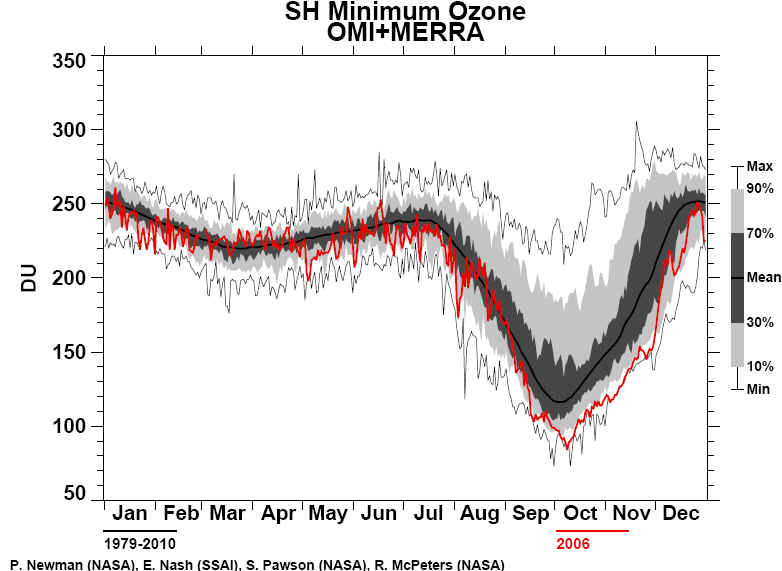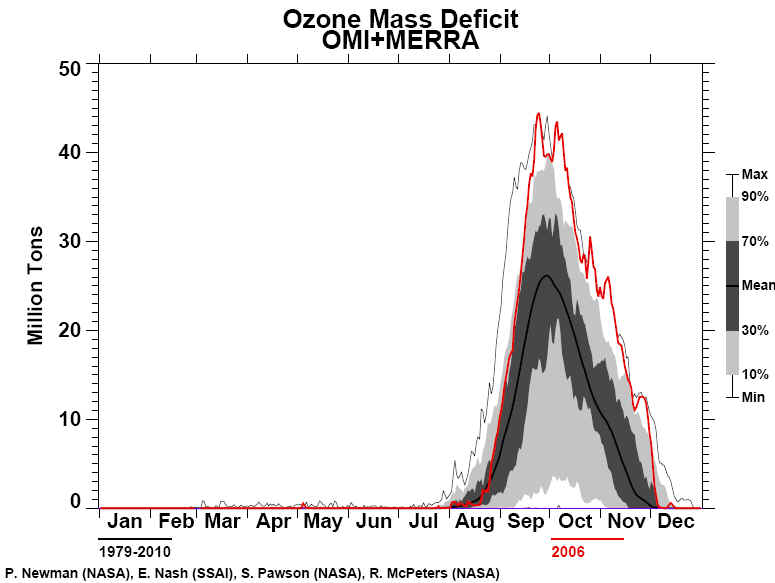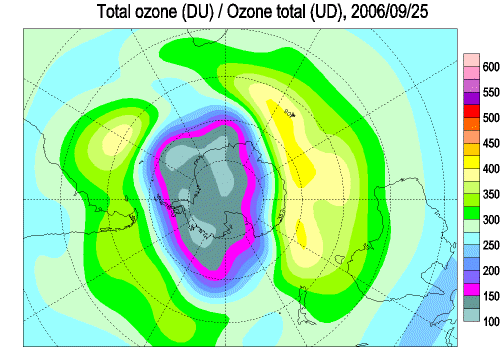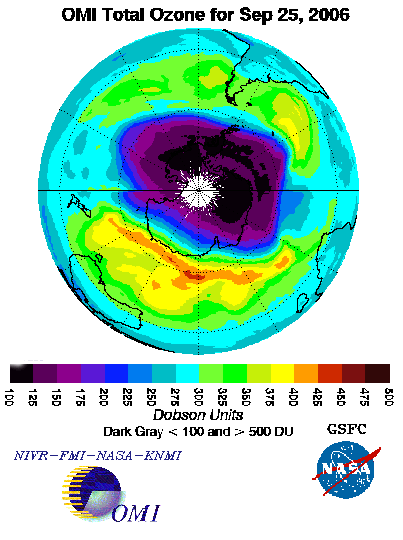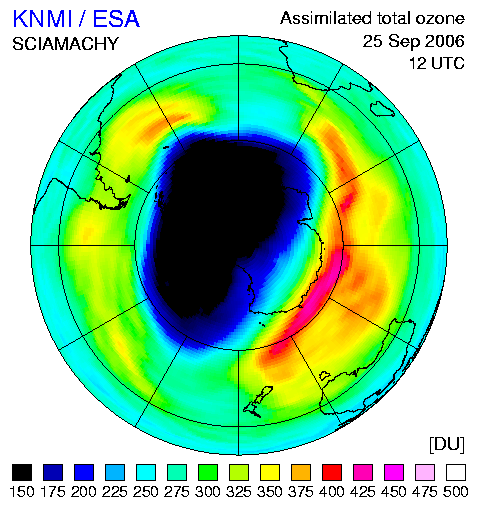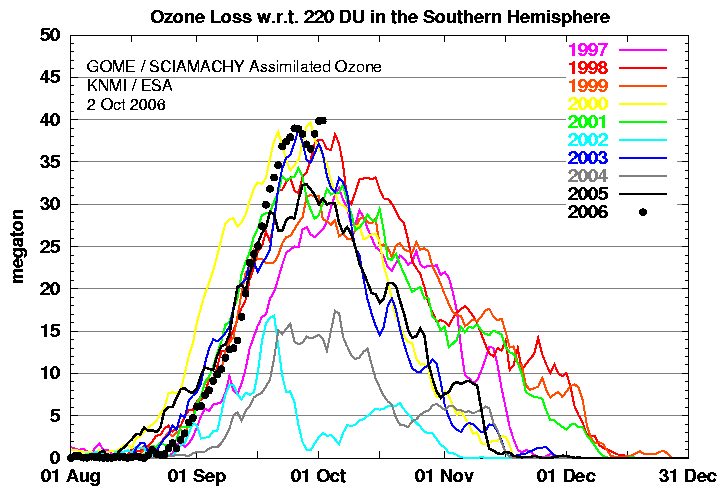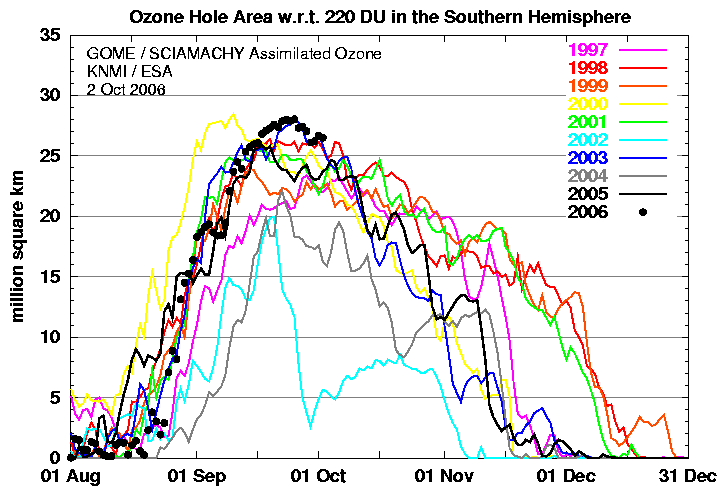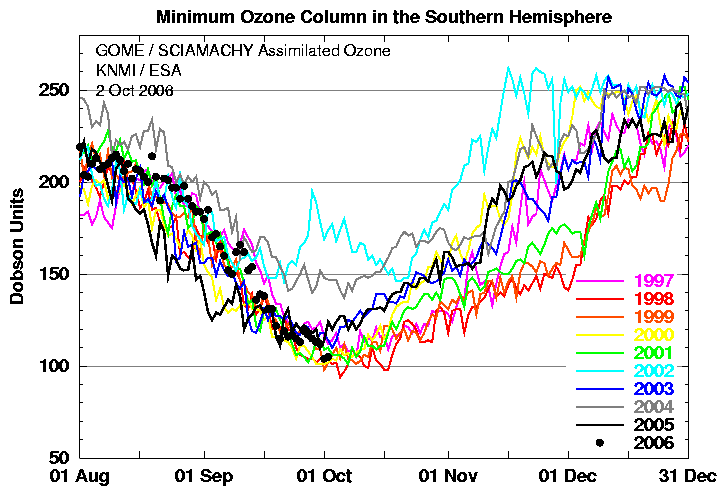Ozone Hole 2006 Largest on Record
http://ozonewatch.gsfc.nasa.gov
NASA and NOAA
Announce Ozone Hole is a Double Record Breaker
10.19.06
The ozone layer acts to protect life on Earth by blocking harmful ultraviolet rays from the sun. The "ozone hole" is a severe depletion of the ozone layer high above Antarctica. It is primarily caused by human-produced compounds that release chlorine and bromine gases in the stratosphere. 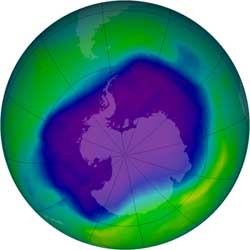 Image right: From September 21-30, 2006 the average area of the ozone
hole was the largest ever observed, at 10.6 million square miles. This
image, from Sept. 24, the Antarctic ozone hole was equal to the record
single-day largest area of 11.4 million square miles, reached on Sept. 9,
2000. Satellite instruments monitor the ozone layer, and we use their data
to create the images that depict the amount of ozone. The blue and purple
colors are where there is the least ozone, and the greens, yellows, and
reds are where there is more ozone. . Credit: NASA
Image right: From September 21-30, 2006 the average area of the ozone
hole was the largest ever observed, at 10.6 million square miles. This
image, from Sept. 24, the Antarctic ozone hole was equal to the record
single-day largest area of 11.4 million square miles, reached on Sept. 9,
2000. Satellite instruments monitor the ozone layer, and we use their data
to create the images that depict the amount of ozone. The blue and purple
colors are where there is the least ozone, and the greens, yellows, and
reds are where there is more ozone. . Credit: NASA"From September 21 to 30, the average area of the ozone hole was the largest ever observed, at 10.6 million square miles," said Paul Newman, atmospheric scientist at NASA's Goddard Space Flight Center, Greenbelt, Md. If the stratospheric weather conditions had been normal, the ozone hole would be expected to reach a size of about 8.9 to 9.3 million square miles, about the surface area of North America. The Ozone Monitoring Instrument on NASA's Aura satellite measures the total amount of ozone from the ground to the upper atmosphere over the entire Antarctic continent. This instrument observed a low value of 85 Dobson Units (DU) on Oct. 8, in a region over the East Antarctic ice sheet. Dobson Units are a measure of ozone amounts above a fixed point in the atmosphere. The Ozone Monitoring Instrument was developed by the Netherlands' Agency for Aerospace Programs, Delft, The Netherlands, and the Finnish Meteorological Institute, Helsinki, Finland. Scientists from NOAA's Earth System Research Laboratory in Boulder, Colo., use balloon-borne instruments to measure ozone directly over the South Pole. By Oct. 9, the total column ozone had plunged to 93 DU from approximately 300 DU in mid-July. More importantly, nearly all of the ozone in the layer between eight and 13 miles above the Earth's surface had been destroyed. In this critical layer, the instrument measured a record low of only 1.2 DU., having rapidly plunged from an average non-hole reading of 125 DU in July and August. "These numbers mean the ozone is virtually gone in this layer of the atmosphere," said David Hofmann, director of the Global Monitoring Division at the NOAA Earth System Research Laboratory. "The depleted layer has an unusual vertical extent this year, so it appears that the 2006 ozone hole will go down as a record-setter." Observations by Aura's Microwave Limb Sounder show extremely high levels of ozone destroying chlorine chemicals in the lower stratosphere (approximately 12.4 miles high). These high chlorine values covered the entire Antarctic region in mid to late September. The high chlorine levels were accompanied by extremely low values of ozone. 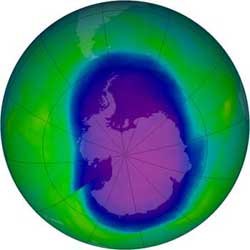 Image left: The ozone hole of 2006 is the most severe ozone hole (least
amount of ozone) observed to date. NASA's Aura satellite observed a low
value of 85 Dobson Units (DU) on Oct. 8 in a region over the East
Antarctic ice sheet. Dobson Units are a measure of ozone amounts above a
fixed point in the atmosphere. This severe ozone hole resulted from the
very high ozone depleting substance levels and the record cold conditions
in the Antarctic stratosphere. . Credit: NASA
Image left: The ozone hole of 2006 is the most severe ozone hole (least
amount of ozone) observed to date. NASA's Aura satellite observed a low
value of 85 Dobson Units (DU) on Oct. 8 in a region over the East
Antarctic ice sheet. Dobson Units are a measure of ozone amounts above a
fixed point in the atmosphere. This severe ozone hole resulted from the
very high ozone depleting substance levels and the record cold conditions
in the Antarctic stratosphere. . Credit: NASAThe temperature of the Antarctic stratosphere causes the severity of the ozone hole to vary from year to year. Colder than average temperatures result in larger and deeper ozone holes, while warmer temperatures lead to smaller ones. The NOAA National Centers for Environmental Prediction (NCEP) provided analyses of satellite and balloon stratospheric temperature observations. The temperature readings from NOAA satellites and balloons during late-September 2006 showed the lower stratosphere at the rim of Antarctica was approximately nine degrees Fahrenheit colder than average, increasing the size of this year's ozone hole by 1.2 to 1.5 million square miles. The Antarctic stratosphere warms by the return of sunlight at the end of the polar winter and by large-scale weather systems (planetary-scale waves) that form in the troposphere and move upward into the stratosphere. During the 2006 Antarctic winter and spring, these planetary-scale wave systems were relatively weak, causing the stratosphere to be colder than average. As a result of the Montreal Protocol and its amendments, the concentrations of ozone-depleting substances in the lower atmosphere (troposphere) peaked around 1995 and are decreasing in both the troposphere and stratosphere. It is estimated these gases reached peak levels in the Antarctica stratosphere in 2001. However, these ozone-depleting substances typically have very long lifetimes in the atmosphere (more than 40 years). As a result of this slow decline, the ozone hole is estimated to annually very slowly decrease in area by about 0.1 to 0.2 percent for the next five to 10 years. This slow decrease is masked by large year-to-year variations caused by Antarctic stratosphere weather fluctuations. The recently completed 2006 World Meteorological Organization/United Nations Environment Programme Scientific Assessment of Ozone Depletion concluded the ozone hole recovery would be masked by annual variability for the near future and the ozone hole would fully recover in approximately 2065. "We now have the largest ozone hole on record for this time of year," said Craig Long of NCEP. As the sun rises higher in the sky during October and November, this unusually large and persistent area may allow much more ultraviolet light than usual to reach Earth's surface in the southern latitudes. Antarctic ozone hole is worst ever recorded, UN reports 3 October 2006 – This year’s hole
in the Antarctic ozone layer is the worst on record, not only matching that of
the year 2000 in surface area but registering the largest depletion ever
measured of the naturally occurring gas that filters out cancer- and
cataract-causing ultraviolet (UV) rays, the United Nations meteorological agency
reported today. Large holes over the Antarctic are expected to reoccur over the next two decades before a clear decline in size and depth, and the Montreal Protocol and Vienna Convention phasing out ozone-destroying chemicals such as chlorofluorocarbons must be adhered to with the utmost vigilance, WMO spokesman Mark Oliver told a news briefing in Geneva. The agency based its assessments on measurements taken by satellites of the United States National Aeronautics and Space Administration (NASA) and European Space Agency (ESA), validated by surface based observations of the WMO Global Atmosphere Watch (GAW) ozone network. NASA instruments showed that on 25 September the area of the hole reached 29.5 million square kilometres, compared to 29.4 million in September 2000. Each agency uses different instruments, giving slightly different values, and according to ESA, the hole reached 28 million square kilometres on 25 September, very close to its maximum for 2000, which peaked at 28.4 million. The ozone mass deficit in 2006 was measured at 39.8 megatonnes on 1 October, higher than in 2000, which peaked at 39.6 megatonnes on 29 September. Mass deficit is the amount of ozone missing from a vertical column of air compared to a baseline measured many decades earlier before severe ozone depletion appeared. Scientists have become increasingly aware of possible links between ozone depletion and climate change. Increased atmospheric concentrations of greenhouse gases will lead to a warmer climate at the Earth’s surface. At altitudes where the ozone layer is found, the same increase is likely to lead to a cooling of the atmosphere, enhancing the chemical reactions that destroy ozone. At the same time, the amount of
water vapour in the stratosphere has been increasing at the rate of about 1 per
cent per year. A wetter and colder stratosphere means more polar stratospheric
clouds, which is likely to lead to more severe ozone loss in both polar regions. 21 December 2006 British Antarctic Survey Ozone Bulletin Ozone levels across Antarctica dropped rapidly in September and were generally at their minimum in early October. They have now risen above ozone hole limits, however a significant area of the southern ocean south of Africa is still experiencing ozone levels substantially below the normal, with a few areas approaching 40% depletion. Lowest levels are currently near 240 DU over parts of the Southern Ocean. Temperatures in the ozone layer are now near summer values, though values remain below the mean of the last few decades. The ozone hole grew rapidly from mid August and reached nearly 28 million square kilometres in size at the equinox. The ozone hole was at record or near record size from mid September until late November, when it began to decline rapidly. Although not an absolute record in size it was a record for the amount of ozone destroyed. When the ozone hole became more elliptical the edge of the ozone hole made passes over the tip of South America and South Georgia and over the latter, uv levels reached similar values to those seen at mid-day in the tropics.
06 December 2006 British Antarctic Survey Ozone Bulletin Ozone levels across Antarctica dropped rapidly in September and were generally at their minimum in early October. They have now risen above ozone hole limits at most locations, however a large area is still experiencing ozone levels substantially below the normal, with a few areas approaching 50% depletion. Lowest levels are currently near 200 DU over parts of the Southern Ocean. The polar vortex is beginning to collapse rapidly. Temperatures within it remain close to the minimum seen over the last few decades, but are rising. The ozone hole grew rapidly from mid August and reached nearly 28 million square kilometres in size at the equinox. The ozone hole was at record or near record size from mid September until late November, when it began to decline rapidly and is now around 3 million square kilometres . Although not an absolute record in size it was a record for the amount of ozone destroyed. When the ozone hole became more elliptical the edge of the ozone hole made passes over the tip of South America and South Georgia and over the latter, uv levels reached similar values to those seen at mid-day in the tropics.
23 November 2006 British Antarctic Survey Ozone Bulletin Ozone levels across Antarctica dropped rapidly in September and were generally at their minimum in early October; they are now slowly rising at most locations. Lowest levels are currently near 200 DU over parts of Antarctica. The polar vortex is shrinking, but remains significantly larger than average for this time of year. Temperatures within it are generally below the normal for the time of year, but are rising. The ozone hole grew rapidly from mid August and reached nearly 28 million square kilometres in size at the equinox. The ozone hole has been at record or near record size since mid September. Although not an absolute record in size it was a record for the amount of ozone destroyed. I t is now shrinking, although at around 13 million square kilometres it is still a record size for mid November.
3 November 2006 British Antarctic Survey Ozone Bulletin Ozone levels across Antarctica dropped rapidly in September and were generally at their minimum in early October; they are now slowly rising at most locations. Lowest levels are currently below 120 DU over parts of Antarctica. The polar vortex is shrinking, but remains significantly larger than average for this time of year. Temperatures within it are generally below the normal for the time of year, but are rising. The ozone hole grew rapidly from mid August and reached nearly 28 million square kilometres in size at the equinox. It was the largest on record for the week preceding the equinox, and although not an absolute record in size it was a record for the amount of ozone destroyed. It is now shrinking, although at around 15 million square kilometres it is near a record size for early November. When the ozone hole becomes more elliptical the edge of the ozone hole can makes passes over the tip of South America and South Georgia.
26 October 2006 British Antarctic Survey Ozone Bulletin Ozone levels across Antarctica dropped rapidly in September and were at their minimum in early October; they are now slowly rising at most locations. Lowest levels are currently below 120 DU over parts of Antarctica. The polar vortex is shrinking, but remains significantly larger than average for this time of year. Temperatures within it are generally below the normal for the time of year. The ozone hole grew rapidly from mid August and reached nearly 28 million square kilometres in size at the equinox. It was the largest on record for the week preceding the equinox, and although not an absolute record in size it was a record for the amount of ozone destroyed. It is now shrinking, although at 19 million square kilometres it is at a record size for late October. The ozone hole has become much more elliptical at times and the edge of the ozone hole then makes passes over the tip of South America and South Georgia.
20 October2006 NASA and National Oceanic and Atmospheric Administration (NOAA) scientists report this year's ozone hole in the polar region of the Southern Hemisphere has broken records for area and depth. "From September 21 to 30, the average area of the ozone hole was the largest ever observed, at 10.6 million square miles," said Paul Newman, atmospheric scientist at NASA's Goddard Space Flight Center, Greenbelt, Md. If the stratospheric weather conditions had been normal, the ozone hole would be expected to reach a size of about 8.9 to 9.3 million square miles, about the surface area of North America.
6 October2006 British Antarctic Survey Ozone Bulletin Ozone levels across Antarctica dropped rapidly in September and are now near their minimum. Lowest levels are currently near 100 DU over parts of Antarctica. The polar vortex is shrinking, but remains significantly larger than average for this time of year. Temperatures within it are generally below the normal for the time of year. The ozone hole grew rapidly from mid August and reached nearly 28 million square kilometres in size at the equinox. It was the largest on record for the week preceding the equinox, although not an absolute record in size and it is now shrinking. The ozone hole has become much more elliptical and the edge of the ozone hole is making passes over the tip of South America. The next pass is expected from October 7 to 10. It also crosses South Georgia and here the next pass is expected from October 9 to 12.
3 October2006 World Meteorological Organization This year’s hole in the Antarctic ozone layer was the most serious on record exceeding that of 2000. Not only was it the largest in surface area (matching 2000) but also suffered the most mass deficit, meaning that there was less ozone over the Antarctic than ever previously measured. Measurements were taken from instruments on both NASA and European Space Agency (ESA) satellites. These are validated by surface based observations of the WMO Global Atmosphere Watch (GAW) ozone network. Each agency uses different instruments hence the slightly different values. NASA instruments showed that, on 25 September 2006, the area of the hole reached 29.6 million km2, compared to 29.4 million km2 reached in September 2000.
The ozone mass deficit in 2006 was measured at 39.8 megatonnes on 1 October, higher than in 2000, which peaked at 39.6 megatonnes on 29 September. Mass deficit is the amount of ozone missing from a vertical column of air compared to a baseline measured many decades earlier before severe ozone depletion appeared. This year’s hole was caused by the continuing presence of peak levels of ozone destroying substances in the atmosphere combined with a particularly cold stratospheric winter.
2 October 2006 European Space Agency-Ozone measurements made by ESA’s Envisat satellite have revealed the ozone loss of 40 million tonnes on 2 October 2006 has exceeded the record ozone loss of about 39 million tonnes for 2000.Full story click here
The ozone loss at 12:00 GMT of each day from GOME (1996-2002) and SCIAMACHY (2003-2006) Assimilated Ozone Fields. The ozone loss is the amount of ozone in megaton necessary to fill the ozone hole to 220 Dobson units (DU) over the whole area. DU stands for the total thickness of ozone in a given vertical column if it were concentrated into a single slab at standard temperature and atmospheric pressure – 400 DUs is equivalent to a thickness of four millimetres, for example. Credits: KNMI/TEMIS
The size of the Antarctic ozone hole at 12:00 GMT of each day from GOME (1996-2002) and SCIAMACHY (2003-2006) Assimilated Ozone Fields. The size of the ozone hole is the area on the globe in million square km of ozone column values below 220 Dobson units (DU). DU stands for the total thickness of ozone in a given vertical column if it were concentrated into a single slab at standard temperature and atmospheric pressure – 400 DUs is equivalent to a thickness of four millimetres, for example. Credits: KNMI/TEMIS
The depth of the Antarctic ozone hole at 12:00 GMT of each day from GOME (1996-2002) and SCIAMACHY (2003-2006) Assimilated Ozone Fields. The depth of the ozone hole is the lowest ozone column value in Dobson Units (DU) for latitudes below 30° South. DU stands for the total thickness of ozone in a given vertical column if it were concentrated into a single slab at standard temperature and atmospheric pressure – 400 DUs is equivalent to a thickness of four millimetres, for example. Credits: KNMI/TEMIS Situation at 2006 September 29 British Antarctic Survey Ozone Bulletin Ozone levels across Antarctica have dropped rapidly since mid September. Lowest levels are approaching 100 DU in parts of Antarctica. The polar vortex is a little larger than it was at this time last year, although it is beginning to shrink. Temperatures within it are generally below the normal for the time of year. The ozone hole grew rapidly from mid August and reached nearly 28 million square kilometres in size at the equinox. It was the largest on record for the week preceding the equinox, although not an absolute record in size. The ozone observing season at Vernadsky and Halley has commenced and both stations are experiencing ozone hole levels. Rothera can make observations throughout the year; here ozone values dropped rapidly in mid September and a minimum of 105 DU was recorded. The edge of the ozone hole is expected to swing over the tip of South America around October 4. A prediction made at the SCAR conference in Hobart in July suggested that the 2006 ozone hole is likely to be one of the larger and deeper ones (perhaps 28 million square kilometres), based on a correlation with the 100 hPa temperature. [This prediction is clearly confirmed.] Adrian Tuck predicts a significant spring warming before mid October. Note: The Antarctic ozone hole is usually largest in early September and deepest in late September to early October. September 16 is world ozone day. Prior to the formation of ozone holes, Antarctic ozone values were normally at their lowest in the autumn (ie March). Situation at 2006 September 22-WMO Bulletin-Since the last Bulletin (12 September) vortex minimum temperatures at 50 hPa continue to remain around 181-182 K, which is well below the frost point and colder than for any year in the 1979-2005 period for this time of the year. The average temperature in the 60-90°S region has increased slightly, from 193 K to 194 K, but is lower than any other year since 1979 for this time of the year. The area where temperatures are low enough for existence of polar stratospheric clouds of type I (NAT) at the 450 K isentropic level (~17 km or ~70 hPa), has continued to decline from its peak (28.9 million km2) in late July to about 21 million km2 on 18 September. Since early July, the south polar vortex has been larger than the 1996-2005 average at the 450, 550 and 650 K isentropic levels. At 450 K, the vortex area has on certain days been as large as the maximum for the 1986-2005 time period. Chlorine activation reached its peak around 1 September and is now declining. There is still a region inside the vortex where hydrochloric acid (HCl) is completely depleted, which is an indication of complete activation. Ozonesonde observations show up to 90% ozone loss in the 15-20 km altitude range by 20 September compared to early August. The area where total ozone is less than 220 DU (also called the "ozone hole area") was relatively small until around 20 August. Since then the ozone hole area has increased more rapidly than the 1979-2005 average and is now close to 28 million km2, which is more than the maximum reached in 2005 (26 million km2) and very close to the maximum reached in 2003. It is still somewhat lower than the ozone hole area in 2000, which peaked at 28.5 million km2 on 10 September. Measurements of total ozone at individual stations and total ozone maps synthesised by the World Ozone and UV Data Centre show that total ozone columns in August and the first half of September were somewhat larger in 2006 as compared to the same time of the year in 2005. The last few days, ozone columns at most stations have dropped rapidly and are now the same as at the same time in 2005. Minimum total ozone columns from satellite observations have dropped rapidly the last days and are now near and even below the values observed in 2005. Predictions based on meteorological forecasts indicate that the vortex will remain relatively concentric and unperturbed, and it is not likely that areas outside Antarctica will be significantly affected by the ozone hole between now and 30 September. The intensity of ultraviolet radiation remains modest, with UV indices not exceeding 3.1 in southern Chile and Antarctica. As ozone depletion continues and the solar elevation increases, UV indices are expected to increase. 0 2 4 6 8 10 12 14 Ozone partial pressure [mPa] Ozone soundings from the Argentinian GAW station Belgrano (78°S, 35°W). One can see the progression of ozone depletion from 2 August until 20 September. In the height region most affected by ozone destruction, the depletion amounts to about 80%. The ozone hole is expected to deepen further over the next couple of weeks. The soundings are carried out as a collaboration between Argentinian researchers and scientists from the Spanish Instituto Nacional de Tecnica Aeroespacial (INTA). Global Atmosphere Watch Situation at 2006 September 16 British Antarctic Survey Ozone Bulletin Ozone levels across Antarctica have dropped rapidly in the last week. Lowest levels are now below 150 DU across a large part of Antarctica. The polar vortex is a little larger than it was at this time last year. Temperatures within it are generally below the normal for the time of year. The ozone hole grew rapidly from mid August and reached some 26 million square kilometres in size in mid September, one of the largest areas on record for this time in September. Situation at 2006 September 14 British Antarctic Survey Ozone Bulletin Ozone levels across the polar vortex are falling, with lowest levels in the edge region, whilst the circumpolar high is building. The polar vortex is a little larger than it was at this time last year. Temperatures within it are generally below the normal for the time of year. The ozone hole grew rapidly from mid August and peaked at some 24 million square kilometres in size in early September, comparable to the hole in 2005. Situation at 2006 September 1 British Antarctic Survey Ozone Bulletin Ozone levels in the sunlit edge region of the polar vortex are falling and are lowest here, whilst the circumpolar high is building. The polar vortex is a little larger than it was at this time last year. Ozone levels in the centre of the vortex are not far from normal as this area is still in darkness. The ozone hole has grown rapidly since mid August and is now some 23 million square kilometres in size, comparable to the hole in 2005. Situation at 2006 August 17 British Antarctic Survey Ozone Bulletin Ozone levels in the sunlit edge region of the polar vortex are falling, whilst the circumpolar high is building. The polar vortex is a little larger than it was at this time last year. The ozone observing season at Vernadsky has commenced, whilst that at Halley commences in late August. Rothera can make observations throughout the year; here ozone values have dropped to ozone hole levels. Situation at 2006 August 2 British Antarctic Survey Ozone Bulletin Ozone levels in the sunlit edge region of the polar vortex are beginning to fall. The ozone observing season at Vernadsky will soon commence, whilst that at Halley commences in late August. Rothera can make observations throughout the year; here ozone values are near ozone hole levels. Andrew Klekociuk of the Australian Antarctic Division predicts that the 2006 ozone hole is likely to be one of the larger and deeper ones (perhaps 28 million square kilometres), based on a correlation with the 100 hPa temperature. Adrian Tuck predicts a significant spring warming before mid October. Note: The Antarctic ozone hole is usually largest in early September and deepest in late September to early October. September 16 is world ozone day. Prior to the formation of ozone holes, Antarctic ozone values were normally at their lowest in the autumn (ie March). Situation at 2006 May 5British Antarctic Survey Ozone Bulletin Generally Antarctic ozone levels are past their autumn minimum, but the polar vortex is spinning up giving a range between 250 DU and 350 DU across the continent.
|
|||||||||||||||||||||||||

